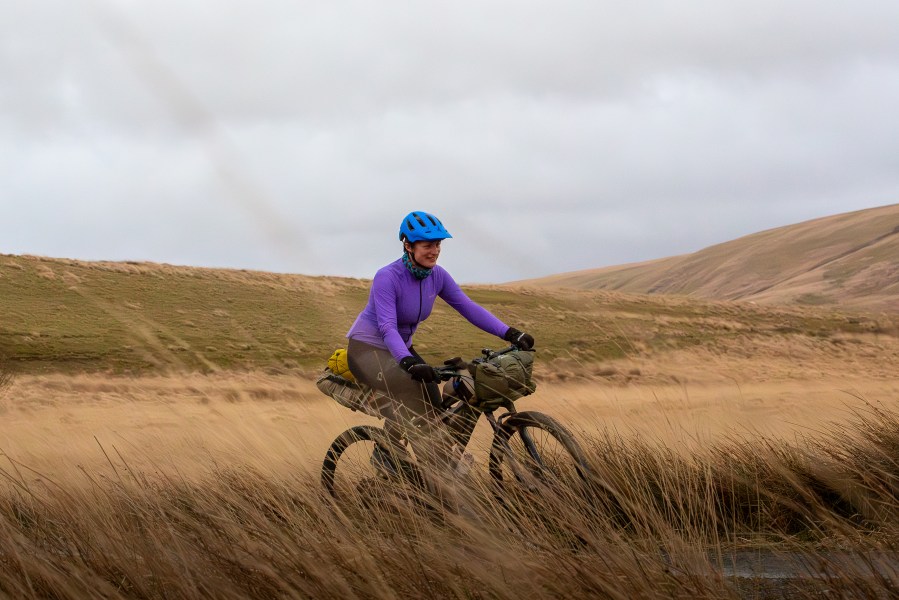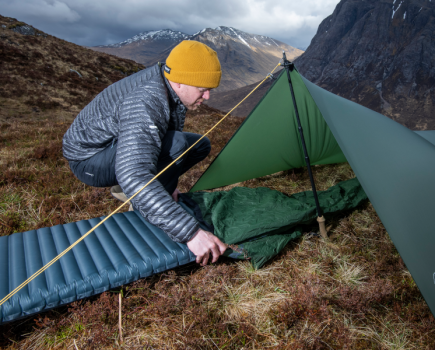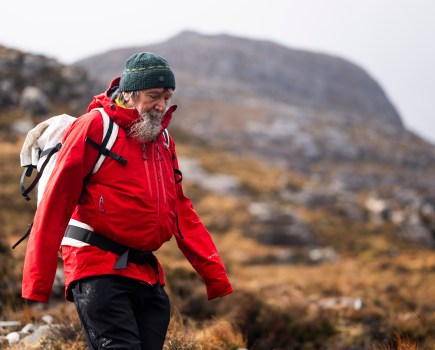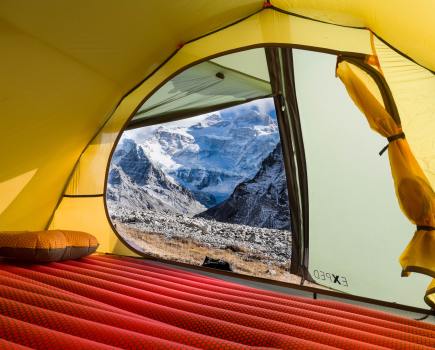Veteran climber, cyclist and adventure photographer Ray Wood explains why you should always expect the worst whilst packing for your next bikepacking trip – and outlines the bits of kit you may not have thought of packing before you head out…
This advertising promotion on how to pack for your next bikepacking trip is sponsored by MSR.
Overnight touring under pedal power has been around many years, but recently it’s become widely known as bikepacking, with a leaning towards traffic-free routes where possible. Around the UK there’s no shortage of itineraries to be found, ranging from straight-forward two-to-three-day routes to arduous remote challenges over a week in length with large amounts of elevation gain. Think of it like walking a long-distance trail and being self-sufficient.
Main image: Sarah Hall crossing Mid Wales on the Trans Cambrian Way | Credit: Ceri Belshaw
Aside from the right bike for the route – often a point of discussion whether a gravel bike or a hardtail mountain bike is best – there’s a long list of equipment dedicated to the activity, starting with bike luggage. This can vary from expensive carbon seatpacks to a holster-style saddle bag at the rear, together with a frame bag, a top tube bag for items needed at hand, and a handlebar bag. If you can avoid carrying a pack then it’ll feel easier.
The key to approaching bikepacking is assuming that what can go wrong will go wrong. You’ll often find yourself a long way from any assistance or a bike shop, even on the Trans Cambrian or other UK multi-day bike routes. Planning beforehand should involve noting the all-important resupply points, campsites and potential escape options.
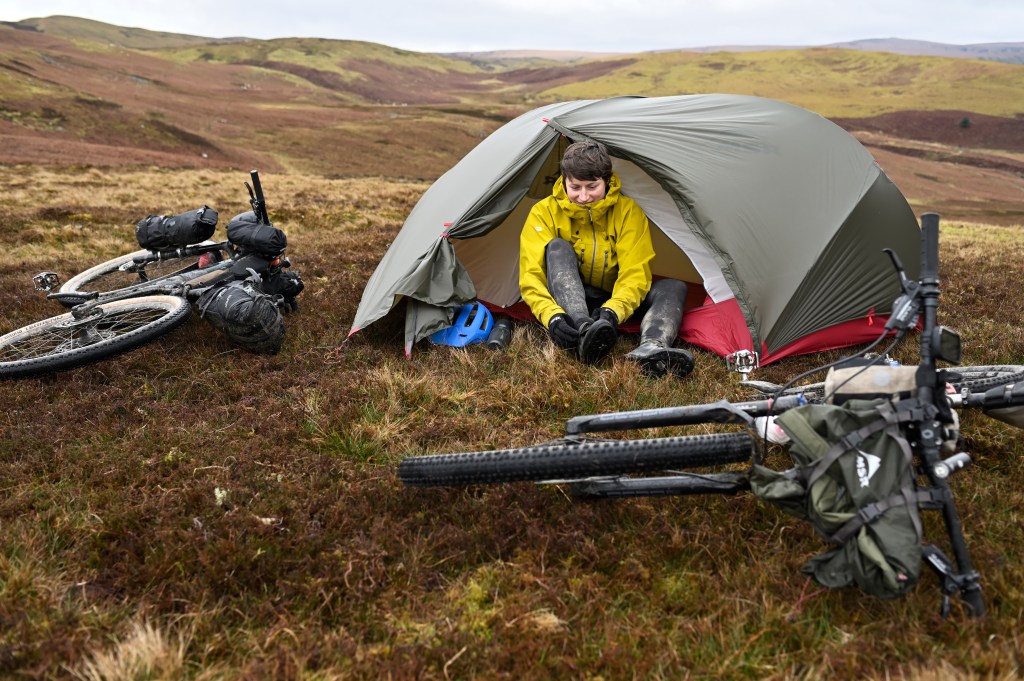
Home for the night above Elan Village. Credit: Ray Wood
Space and weight are critical considerations for equipment. Aside from the usual overnight gear of a lightweight tent – such as the MSR Hubba Hubba Bikepack 2 – sleeping bag and mat, stove (including a lighter) and cooking pot there is a long tick-list of other items to carry.
A multi-tool
A multi-tool will let you take a wheel off and solve various mechanical issues. A spare chain-link takes up no room and will save the day if you break your chain but you’ll need to have a chain tool on your multi-tool to remove a broken link. Some chain lube will keep the drive chain running smoothly.
A spare hanger
A spare hanger – the piece of aluminium that attaches the rear dérailleur to the bike – is often overlooked. But if you bend the hanger by crashing or dropping your bike then life is suddenly going to get problematic with changing gear. And it doesn’t have to be much out of true to affect the gears. I’ve got through three hangers in two years.
Spare brake pads are worth considering for longer rides as pads can wear down surprisingly quickly in wet, gritty conditions.
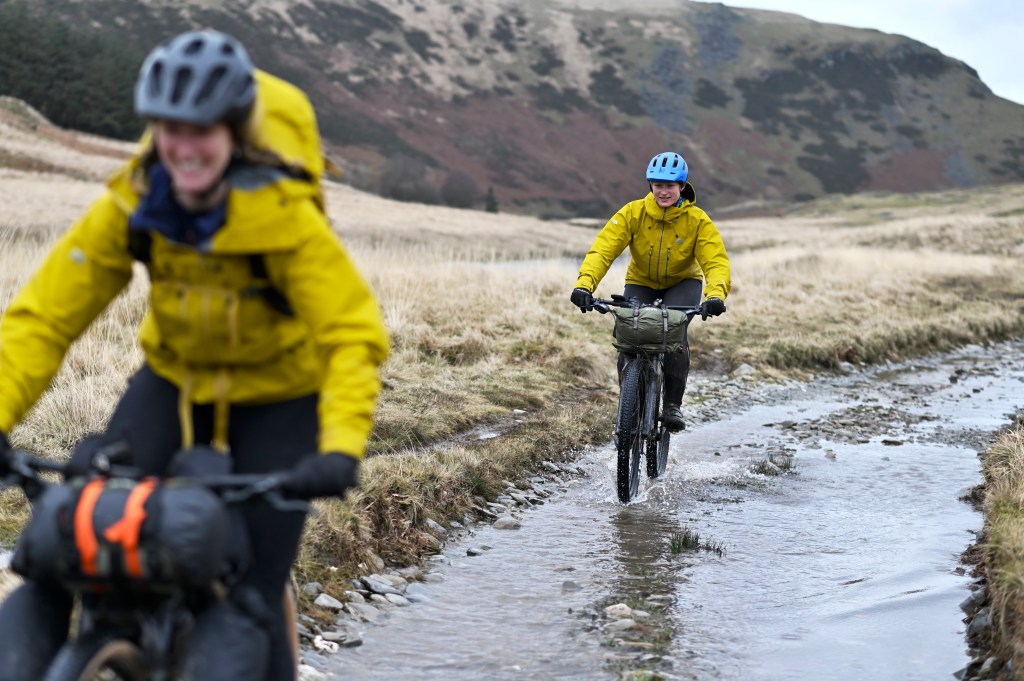
On the Trans Cambrian Way. Credit: Ray Wood
Inner tube
If you run tubeless tyres, then carrying an inner tube is still wise in case for some reason the sealant isn’t working or you get a large cut or split in the tyre. Tyre levers are going to be needed to get the tyre on and off. A patch of any durable material on the inside, known as a tyre boot, will let you cover such damage. The inside of a toothpaste tube can be used in an emergency.
Gorilla tape is also useful for this and several other potential repairs. For small holes in a tubeless set-up, it’s worth carrying a plug kit to fix punctures. It goes without saying a pump is needed.
Emergency snacks
Hitting the wall and running out of steam isn’t what you want. Often resupply points can be a long way apart or a shop may be unexpectedly closed, so have some emergency snacks tucked away just in case. This will also ease any anxiety about running out of energy.
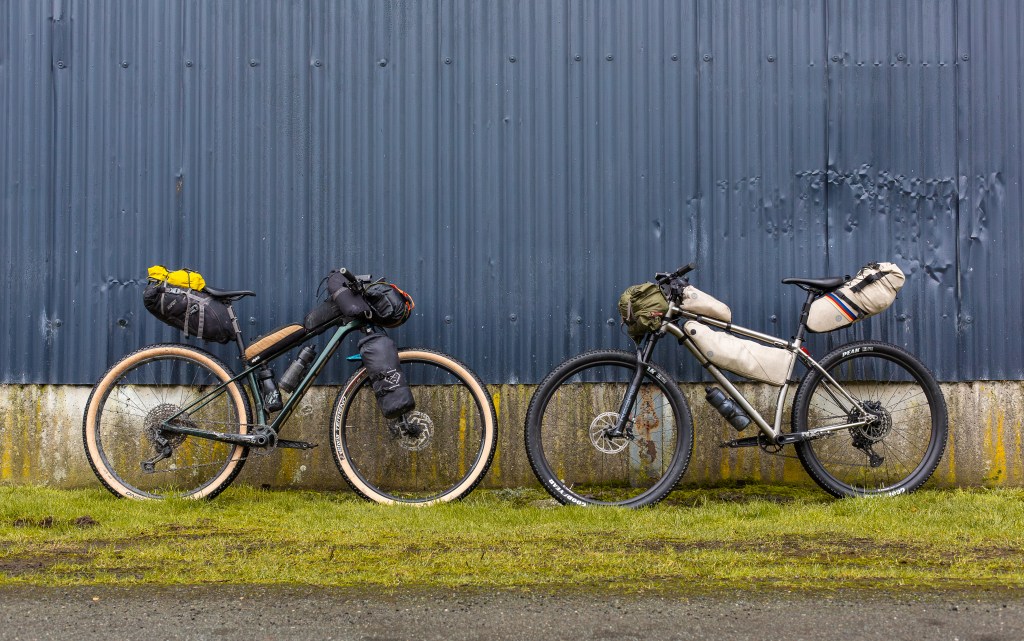
Packing made perfect when shared between two people. Credit: Ceri Belshaw
Electricals
Bike lights are a good idea even if you don’t plan to ride in the dark. And a headtorch is useful for setting up camp and in the tent. Powering electricals can range from a dynamo hub on the bike to simply carrying a power bank along with being savvy about keeping everything charged when you stop at a café or pub. Most bike GPS units onto which you’ll have loaded your route before setting off will last at least 24 hours.
Warm and waterproof clothing
Never underestimate how quickly you’ll chill when you stop pedalling, either to rest or if you must make a trail-side repair. A warm jacket is invaluable. It’s usual to carry waterproofs in the UK unless there’s a rare heatwave. Spare gloves and socks will make life more comfortable.
Additional lifesavers
Your backside may thank you for some sort of chamois cream to avoid the dreaded saddle sores. Three or four cable-ties can prove a lifesaver for a myriad of unforeseen issues. Last and perhaps the most important item in the toolkit is bringing a can-do and positive attitude that will make life easier and far more enjoyable when you run into problems. So long as you’re moving forward you are winning.
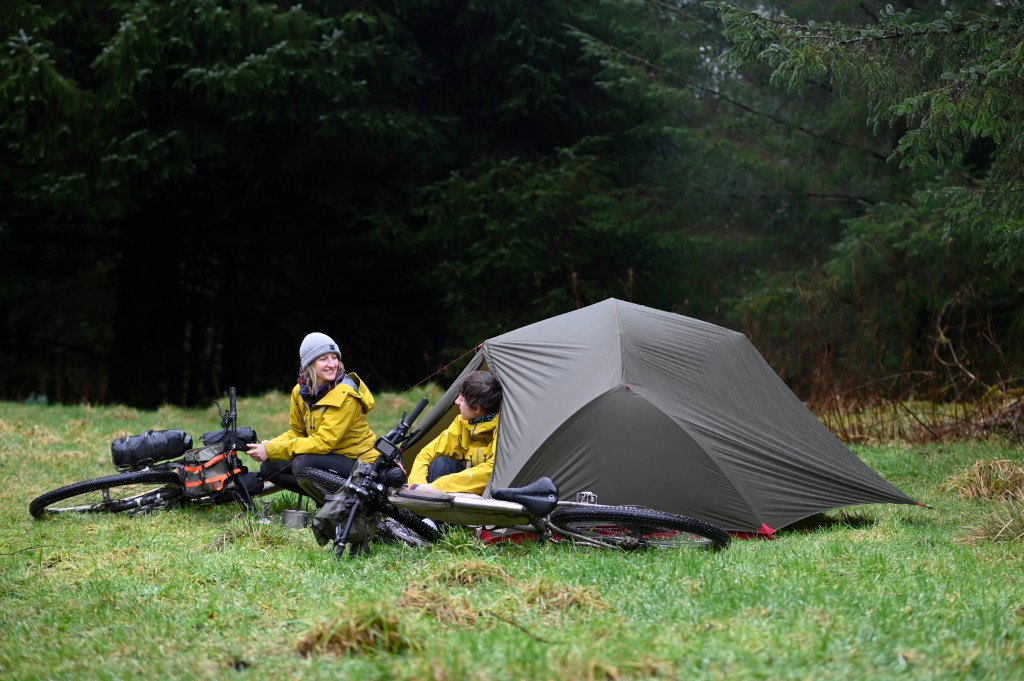
Camp in the shelter of Esgair Ychion forest – a relief to pitch quickly. Credit: Ray Wood
The MSR Hubba Hubba Bikepack 2: a home on two wheels
When Ceri Belshaw and Sarah Hall set out to cross Wales by bike, nothing could have prepared them for the wild wind, wet, and relentless mud. They soon discovered that company was key to getting through some of the toughest mountain bike miles of their lives. Building on the success of the Hubba Hubba with backpackers, MSR has designed a new model with cycle-specific features – the Hubba Hubba Bikepack 2 – so you and your adventure companion can go further and stay out longer on two wheels.
Packable
The waterproof Handlebar Bag is designed to attach seamlessly to flat or drop bars, and removable spacers ‘float’ the bag away from handlebars to free up real estate for hands or accessories. A head tube bungee keeps things stable off-road. Short-folded poles also pack well into packs and panniers. With a minimum weight of 1.4kg, the Hubba Hubba Bikepack 2 is pretty lightweight, too.

The packable MSR Hubba Hubba Bikepack 2. Credit: Ray Wood
Space
As Ceri and Sarah discovered, tough days are better shared – but you still need room to stretch sore legs and rest. The Hubba Hubba Bikepack 2 boasts a rectangular rather than a tapered footprint, offering good head height and plenty of width wiggle room. The tent feels easily spacious enough for two.
Storage
You can’t always bank on good weather – especially when crossing the Cambrian Mountains! Luckily, the overhead ‘gear hammock’ makes it easy to organise and dry out damp kit. There are option exterior clothes lines, too, and oversized side-entry vestibules in which to store all that gear. Cleverly designed tech-compatible pockets even have cable ports for cord management.
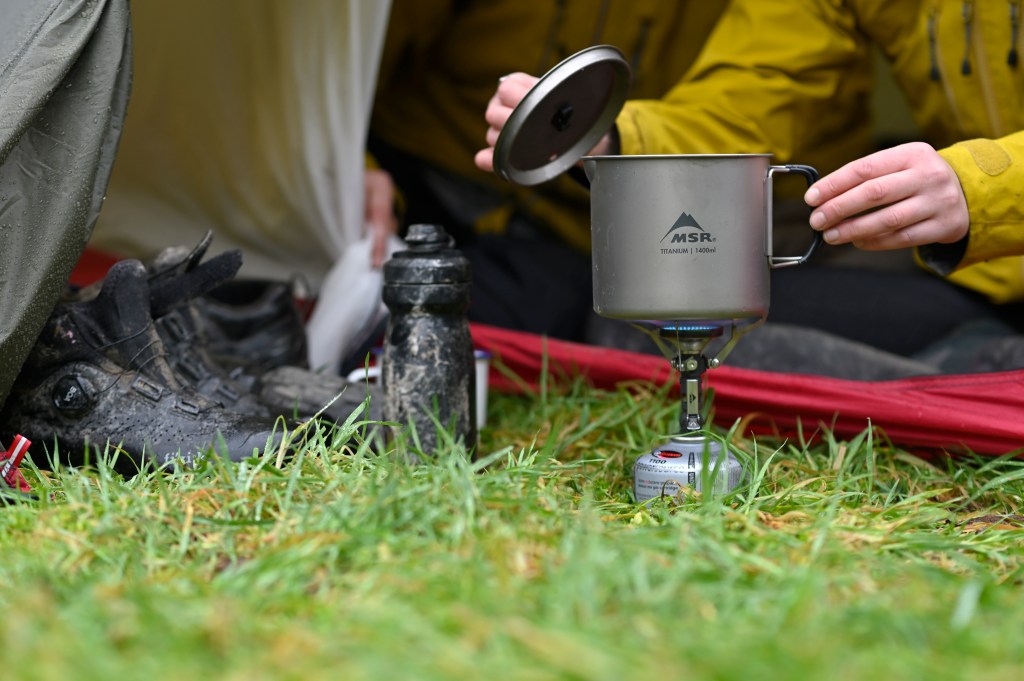
Tea for two. Credit: Ray Wood
Ventilation
After a sweaty and rainy day of riding, two large StayDry doors with a built-in rain gutter and kickstand vents offer extra ventilation. No doubt, your bikepacking companion will be grateful.
Durability
Waterproofing is essential in Wales! A PEU fabric coating and taped seams – as well as reinforced patches, stitching at guy points and locking anodised stake loop grommets – keep the elements at bay.
Learn more at MSR.

